Setofusarium (Nirenberg & Samuels) Crous & Sand.-Den., gen. et stat. nov. Figs 8, 45.
MycoBank number: MB 838678; Index Fungorum number: IF 838678; Facesoffungi number: FoF 11008;
Basionym: Fusarium sect. Setofusarium Nirenberg & Samuels, Canad. J. Bot. 67: 3376. 1989.
Etymology: The name refers to the presence of setose sporodochia and to its resemblance to the genus Fusarium.
Type species: Fusarium setosum Nirenberg & Samuels, Canad. J. Bot. 67: 3372. 1989.
Ascomata perithecial, solitary or gregarious on a well-developed immersed stroma composed of pseudoparenchymatous to hyphal cells, scaly to warty and thick-walled, pyriform, dark red with an often darker red-coloured, flattened and non-papillate apical region, turning darker in KOH, pigment dissolving in lactic acid to become yellow, lacking hairs. >Ascomatal wall of two regions: outer region of thick-walled, pigmented cells of textura angularis to textura globulosa at warts cells; inner region of elongate, hyaline, thin-walled cells, becoming thinner towards the centrum. Asci cylindrical to clavate, with rounded to flattened simple apex, 8- spored, ascospores overlapping uniseriate to biseriate. Ascospores ellipsoidal, 1-septate, not constricted at septum, pale yellow-brown, smooth-walled to finely striate. Conidiophores mononematous (aerial) or grouped on sporodochia. Aerial conidiophores unbranched or rarely branched, bearing terminal phialides; conidiogenous cells monophialidic, cylindrical to sub- cylindrical, smooth- and thin-walled, with periclinal thickening inconspicuous to evident, producing only macroconidia. Sporodochia grey; setae arising between and around sporodochia, stiff, erect, thick-walled with acute tip, at first hyaline later becoming pale golden brown; sporodochial conidiophores irregularly and verticillately branched and densely packed, consisting of short, often swollen, smooth- and thin-walled stipes bearing apical whorl of 2–3 monophialides or single, terminal monophialides; sporodochial conidiogenous cells monophialidic, cylindrical to sub- cylindrical, smooth- and thin-walled, with inconspicuous to evident periclinal thickening. Macroconidia formed in off-white or grey slimy masses, cylindrical, (0–)3–5(–7)-septate, gently curved, with a blunt apical cell and an obtuse to poorly developed foot-shaped basal cell. Microconidia unknown. Chlamydospores unknown. [Description adapted from Samuels & Nirenberg (1989)].
Diagnostic features: Dark red perithecia producing cylindrical to clavate asci containing ellipsoidal, 1-septate, finely striate ascospores and fusarioid asexual morph characterised by mono- phialides producing robust, almost cylindrical macroconidia from aerial conidiophores and setose sporodochia, lacking micro- conidia as well as chlamydospores.
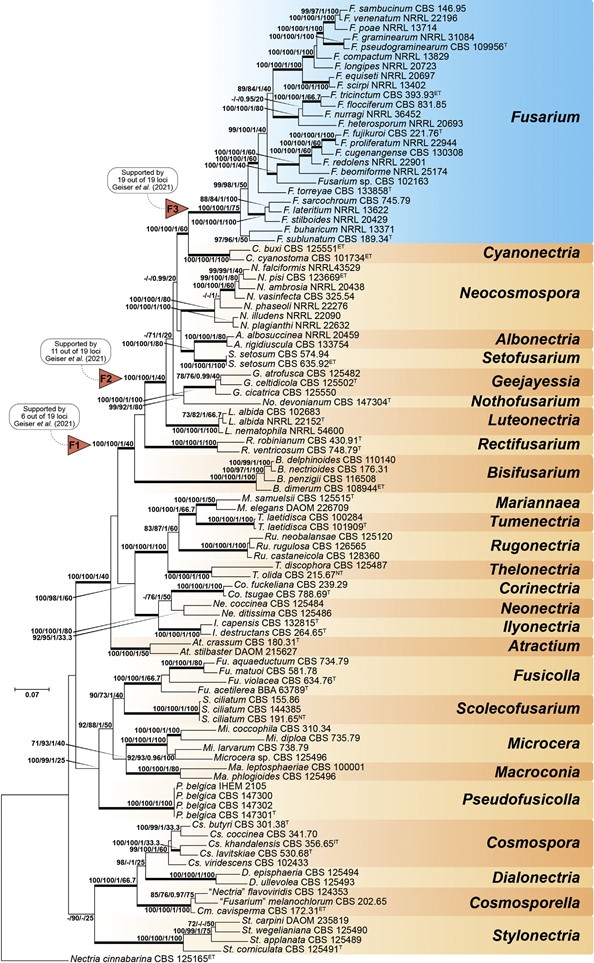
Fig. 7. Maximum-Likelihood (IQ-TREE-ML) consensus tree inferred from the combined ITS, LSU, rpb1, rpb2 and tef1 multiple sequence alignment of members of Nectriaceae. Numbers at the branches indicate support values (RAxML-BS / UFboot2-BS / BI-PP / gCF) above 70 % / 0.95 with thickened branches indicating full support (RAxML-BS / UFboot2-BS / gCF = 100 %; BI-PP = 1). The scale bar indicates expected changes per site. The tree is rooted to Nectria cinnabarina (CBS 125165). Arrows “F1”, “F2” and “F3” indicate the three alternative Fusarium hypotheses sensu Geiser et al. (2013). Ex-epitype, ex-isotype, ex-neotype and ex-type strains are indicated with ET, IT, NT, and T, respectively.
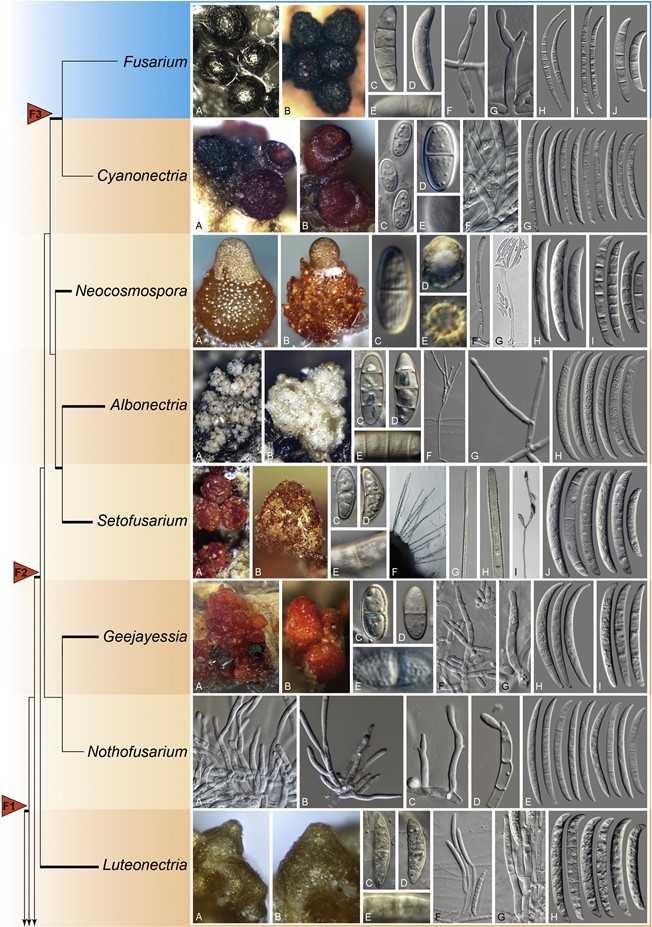
Fig. 8. (Continued).
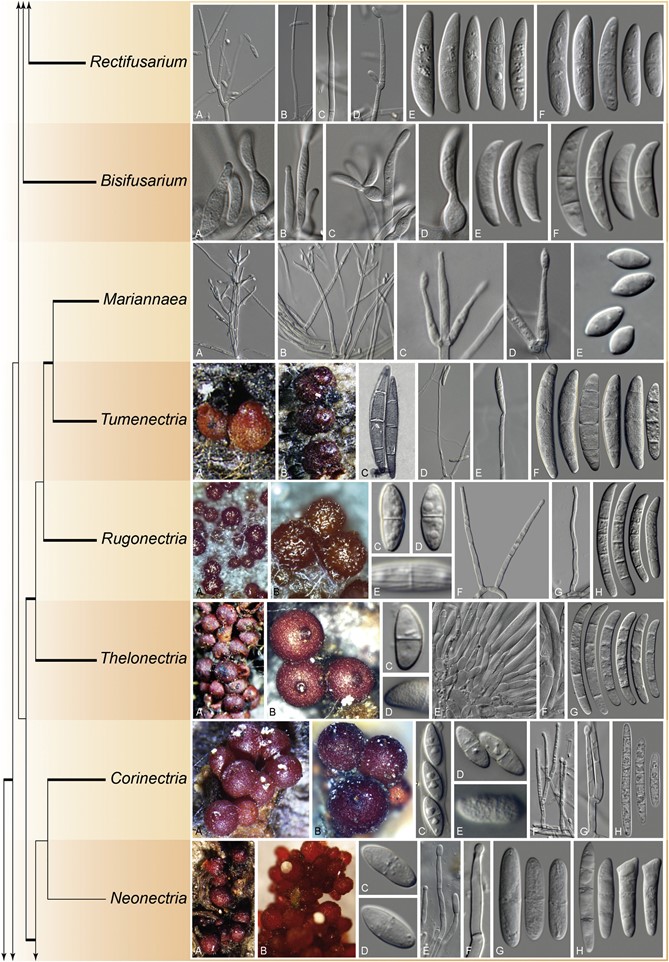
Fig. 8. (Continued).
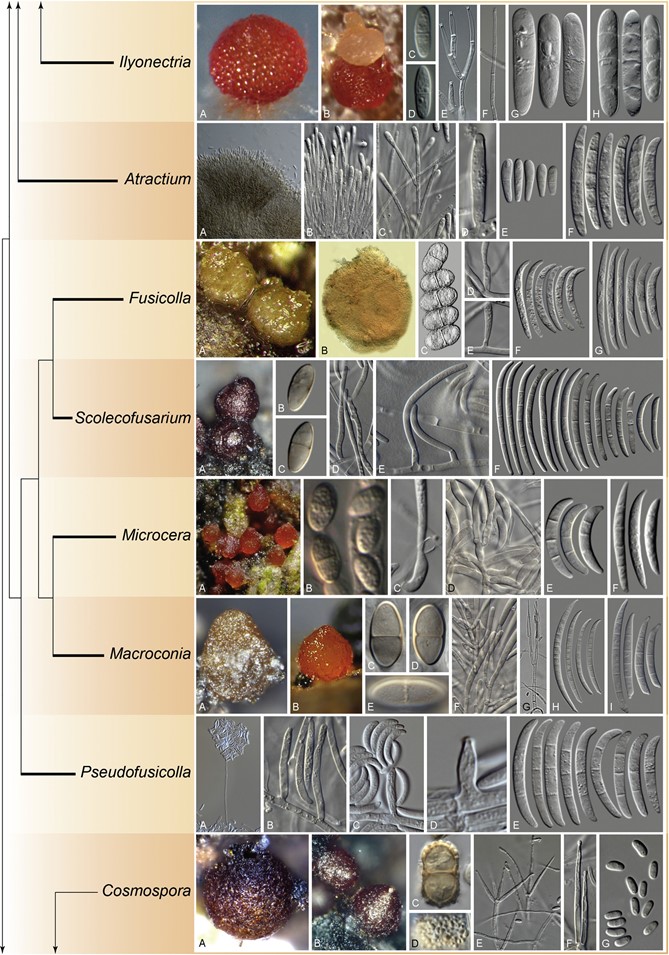
Fig. 8. (Continued).
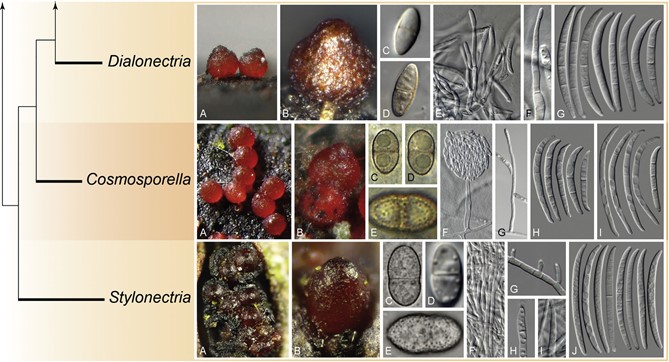
Fig. 8. Morphological features and phylogenetic affinities of fusarioid genera of Nectriaceae and close relatives. The tree was delineated based on the phylogeny presented in Fig. 7 and does not indicate phylogenetic distances. Fully supported branches are indicated in bold. The genus Fusarium is indicated in blue. Arrows “F1”, “F2” and “F3” indicate the three alternative Fusarium hypotheses sensu Geiser et al. (2013). Fusarium. A, B. Ascomata. C– E. Ascospores. F, G. Conidiogenous cells. H– J. Macroconidia. (B. Adapted from Schroers et al. 2011). Cyanonectria. A, B. Ascomata. C–E. Ascospores. F. Conidiogenous cells. G. Macroconidia. Neocosmospora. A, B. Ascomata. C–E. Ascospores. F, G. Conidiogenous cells. H, I. Macroconidia. [A. Adapted from Sandoval-Denis & Crous (2018). G. Adapted from Sandoval-Denis et al. (2019)]. Albonectria. A, B. Ascomata. C–E. Ascospores. F, G. Conidiophores and conidiogenous cells. H. Macroconidia. Setofusarium. A, B. Ascomata. C–E. Ascospores. F– H. Setae formed on sporodochia. I. Conidiophore. J. Conidia. Geejayessia. A, B. Ascomata. C–E. Ascospores. F, G. Conidiophores and conidiogenous cells. H, I. Macroconidia. [A. Adapted from Schroers et al. (2011)]. Nothofusarium. A–D. Conidiophores and conidiogenous cells. E. Conidia. Luteonectria. A, B. Ascomata. C– D. Ascospores. F, G. Conidiophores and conidiogenous cells. H. Conidia. Rectifusarium. A– D. Conidiophores and conidiogenous cells. E, F. Conidia. Bisifusarium. A– D. Conidiophores and conidiogenous cells. E, F. Conidia. Mariannaea. A, B. Conidiophores. C, D. Conidiogenous cells. E. Conidia. Tumenectria. A, B. Ascomata. C. Ascospores. D, E. Conidiophores and conidiogenous cells. F. Conidia. [A– C. Adapted from Salgado-Salazar et al. (2016)]. Rugonectria. A, B. Ascomata. C– E. Ascospores. F, G. Conidiophores and conidiogenous cells. H. Conidia. Thelonectria. A, B. Ascomata. C, D. Ascospores. E, F. Conidiophores and conidiogenous cells. G. Conidia. Corinectria. A, B. Ascomata. C– E. Ascospores. F, G. Conidiophores and conidiogenous cells. H. Conidia. (H. Picture by C. Gonz´alez). Neonectria. A, B. Ascomata. C, D. Ascospores. E, F. Conidiophores and conidiogenous cells. G, H. Conidia. [A. Adapted from Chaverri et al. (2011)]. Ilyonectria. A, B. Ascomata. C, D. Ascospores. E, F. Conidiophores and conidiogenous cells. G, H. Conidia. Atractium. A, B. Conidiophores. C, D. Conidiogenous cells. E, F. Conidia. Fusicolla. A, B. Ascomata. C. Ascospores. D, E. Conidiogenous cells. F, G. Conidia. (A–C. Pictures by C. Lechat). Scolecofusarium. A. Ascomata. B, C. Ascospores. D, E. Conidiophores and conidiogenous cells. F. Conidia. Microcera. A. Ascomata. B. Ascospores. C, D. Conidiogenous cells. E, F. Conidia. (A, B. Pictures by N. Aplin, Fungi of Great Britain and Ireland). Macroconia. A, B. Ascomata. C–E. Ascospores. F, G. Conidiophores and conidiogenous cells. H, I. Conidia. (B. Picture by P. Mlˇcoch). Pseudofusicolla. A, B. Conidiophores and conidiogenous cells. C, D. Conidia. [A– D. Adapted from Triest et al. (2016)]. Cosmospora. A, B. Ascomata. C, D. Ascospores. E, F. Conidiophores and conidiogenous cells. G. Conidia. Dialonectria. A, B. Ascomata. C– E. Ascospores. F, G. Conidiophores and conidiogenous cells. H. Conidia. (A. Picture by P. Mlˇcoch). Cosmosporella. A, B. Ascomata. C–E. Ascospores. F, G. Conidiophores and con- idiogenous cells. H, I. Conidia. (A–E. Pictures by P. Mlˇcoch). Stylonectria. A, B. Ascomata. C– E. Ascospores. F– I. Conidiophores and conidiogenous cells. J. Conidia. (A–C, E. Pictures by B. Wergen).

Fig. 45. Setofusarium setosum. A– C. Ascomata on natural substrate. D. Surface view of perithecial wall in lactic acid. E. Ascus. F–H. Ascospores (H. Surface view). I, J. Setose sporodochia. K–M. Setae. N–P. Detail of setae (N. Base. O. Middle portion wall. P. Surface view of apical wall). Q. Conidiophore. R. Macroconidia. A– H. BPI 882043. I– R. CBS 635.92. Scale bars: A–C, I, Q = 100 μm; J– L = 20 μm; H, P = 5 μm; all others = 10 μm.
Species
Fusarium setosum
